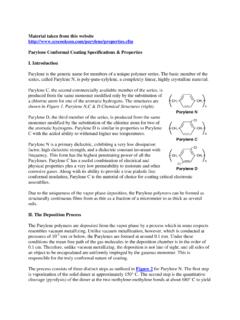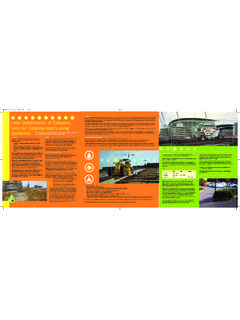Transcription of Technical Note: Guided Wave Radar Interface …
1 Technical Note00840-0400-4530, Rev AAOctober 2014 ContentsIntroduction ..page 1 GWR advantages ..page 1 Criteria for Interface measurement with GWR ..page 3 Interface measurements in chambers ..page 7 Interface measurements in tanks ..page 13 Emulsion/rag layer ..page 14 GWR measurements with stilling well ..page 16 GWR limitations and alternative solutions ..page 17 References ..page quality of the final product depends in many cases on how well raw materials separate, therefore, reliable data about actual Interface level is crucial. Interface applications are very common in many industries, particularly in Oil & Gas, where, for example, oil/water Interface needs to be solutions can be used, but it is Guided Wave (GWR) Radar that has become a popular solution in a wide range of Interface applications across different industries.
2 This Technical note provides comprehensive yet simple guidelines on how to achieve reliable Interface measurements using Guided Wave advantagesGWR provides accurate and reliable Interface measurements and can be used in a wide variety of applications. It is a top-down, direct measurement as it measures the distance to the product surface. GWR can be used with liquids, sludges, slurries, and some key advantage of Radar is that changes in pressure, temperature, and most vapor space conditions have no impact on the accuracy of its level measurements. Moreover, no compensation is necessary for changes in dielectric, conductivity, or density of the density is one of the major issues when measuring level or Interface using older technologies, such as displacers; they are more likely to happen due to changes in process or ambient conditions, and thus have more influence on the reliability and accuracy of density based technologies.
3 GWR, in turn, provides reliable and maintenance-free addition, Radar devices have no moving parts, so maintenance is minimal. GWR is easy to install and enables simple replacement of older technologies, even while there is liquid in the Wave Radar Interface Measurement2 Technical Note00840-0400-4530, Rev AAGuided Wave Radar Interface MeasurementOctober 2014 Guided Wave Radar Interface of operationGWR technology is based on the Time Domain Reflectometry (TDR) principle. Low power nano-second-pulses are Guided along a probe submerged in the process media. When a pulse reaches the surface of the material it is measuring, part of the energy is reflected back to the transmitter, and the time difference between the generated and reflected pulse is converted into a distance from which the total level or Interface level is speed of travel of the pulse is impacted by the dielectric of the medium.
4 As the pulse travels through a different medium, such as oil, the speed of travel changes. This change in travel time is predictable and allows compensation for the measurement to be reflectivity of the product is a key parameter for measurement performance. A high dielectric constant (DC) of the media gives better reflection and a longer measuring 1. Typical GWR Level and InterfaceWhen there are two immiscible layers of fluid, and the lower dielectric fluid is the first seen by the GWR, most of the Radar signal travels through the low dielectric material. Only a small part of the signal is reflected back to the device. When measuring level of products such as oil, with a dielectric of 2, less than 5% of the signal is reflected back to the transmitter.
5 The rest of the signal travels through to the next fluid, which allows the Interface of the two fluids to be measurement accuracy depends on process conditions, such as product dielectric and a distinct Interface between the two of typical GWR Interface applications are oil over water, oil over acid, low dielectric organic solvents over water, low dielectric organic solvents over acid. Low dielectric organic solvents include: toluene, benzene, cyclohexane, hexane, turpentine, , GWR devices provide efficient Interface measurements and easy configuration for both Interface and level pulseUpper product levelInterface levelDistanceAmplitudeUpper productLower product3 Technical Note 00840-0400-4530, Rev AAGuided Wave Radar Interface MeasurementOctober 2014 Guided Wave Radar Interface for Interface measurement with GWRR osemount GWR offering consists of three series: Rosemount 3300 Series: versatile, easy to use, and handles most liquid storage and monitoring applications with ease.
6 Rosemount 5300 Series: superior device for challenging applications, for longer-distance performance with lower dielectrics and higher accuracy. Rosemount 3308 Series: wireless Guided wave Radar , perfect for remote locations with no 3301/5301/3308 Axx1 are recommended for level or Interface measurement in applications where the probe is fully submerged in the liquid. These are mostly chamber installations. Only Interface is measured in the submerged probe 3302/5302/3308 Axx2 can be used to measure both level and Interface . These products are recommended mostly for tank installations. Chamber installations are possible for level and Interface in some cases but are not 2. Interface Level Measurement3301/5301/3308 Axx1 Interface levelUpper product levelInterface level3302/5302/3308 Axx2 Interface measurement in chamber with fully submerged probeLevel and Interface measurement in tank4 Technical Note00840-0400-4530, Rev AAGuided Wave Radar Interface MeasurementOctober 2014 Guided Wave Radar Interface MeasurementIf Interface will be measured, the criteria according to Figure 3 must be fulfilled:Figure 3.
7 Interface Application upper product thicknessThe maximum allowable upper product thickness/measuring range is primarily determined by the dielectric constants of the two liquids. The maximum upper product thickness for the flexible single probe is presented in Figure 4 for the Rosemount 5300 Series and Figure 5 for the Rosemount 3308 Series. However, characteristics may vary between the different applications.> 20< 3 Max DC DCMaxMinTarget applications Low (<3) dielectric constant of upper product High (>20) dielectric constant of lower productUpper product DC Must be known and should be constant. Must have a lower DC than the lower detectable upper product thickness, in. (m)Upper product DC: product DC: 80330053003308 Rigid single leadN/A(1) ( ) ( )Flexible single leadN/A(1)(1)Application dependent.
8 For more information consult your local Emerson ( ) ( )Coaxial4 ( ) ( )(2)(2)8 in. ( m) for HTHP coaxial ( )Rigid twin lead4 ( ) ( )N/A(3)(3)Not in the scope of product twin lead8 ( ) ( ) ( )Difference between dielectric constants for the two products 3300: Larger than 10 5300: Larger than 6 3308: Larger than 10 Maximum upper product thickness Primarily determined by the dielectric constants of the two liquids, see section Maximum upper product thickness for dielectric constant for upperproduct330053003308 Rigid single leadN/A(1)85 Flexible single leadN/A(1)(1)Application dependent. For more information consult your local Emerson twin lead57N/A(2)(2)Not in the scope of product twin lead575 Upper productLower product5 Technical Note 00840-0400-4530, Rev AAGuided Wave Radar Interface MeasurementOctober 2014 Guided Wave Radar Interface MeasurementFigure 4.
9 Rosemount 5300 Series - Maximum Upper Product Thickness for the Flexible Single Lead ProbeFigure 5. Rosemount 3308 Series - Maximum Upper Product Thickness for the Flexible Single Lead ProbeNote5300: Maximum distance to the Interface = 164 ft (50 m) - maximum upper product : Maximum distance to the Interface = ft (17 m) - maximum upper product (5)33 (10)49 (15)66 (20)82 (25)98 (30)115 (35)8040201010 Upper product DCMaximum Upper Product Thickness, ft (m)Lower product DCExample:With an upper product DC of 2, and a lower product DC of 20, the maximum upper product thickness is 62 ft (19 m).DC 2DC 2062 ft (19 m) (2) (4) (6) (8) (10) (12)243567891011808040201010 Lower product DCUpper product DCExample: With an upper product DC of 2, and a lower product DC of 20, the maximum upper product thickness is ft ( m).
10 Maximum Upper Product Thickness, ft (m)DC 2DC ft ( m)6 Technical Note00840-0400-4530, Rev AAGuided Wave Radar Interface MeasurementOctober 2014 Guided Wave Radar Interface MeasurementDielectric constant determination using GWR probeThe correct upper product DC value is vital for accurate GWR Interface measurements. In case it is not known, the Rosemount GWR configuration software has tools to determine it in field: Dielectric Constant Chart and Dielectric Constant Calculator, which can be accessed through Radar Configuration Tools, Rosemount Radar Master, AMS or any DD- or DTM -compatible software 6. Dielectric Constant Chart and Dielectric Constant CalculatorThe Dielectric Constant Chart contains DC values for many products at certain more precise DC value is needed.













![ABSTRACT arXiv:1409.1556v6 [cs.CV] 10 Apr 2015](/cache/preview/4/e/0/e/4/4/2/c/thumb-4e0e442c20fc4f8e108fa20a1095af07.jpg)


